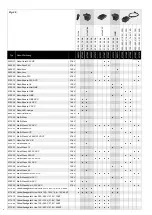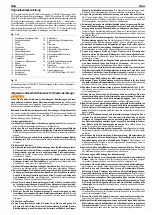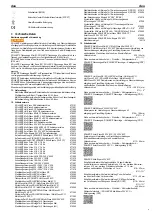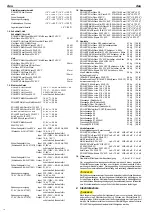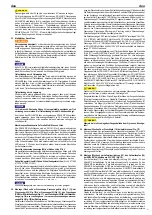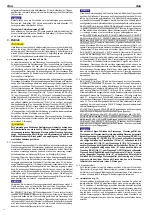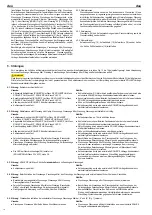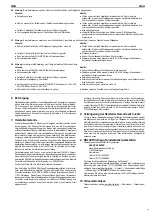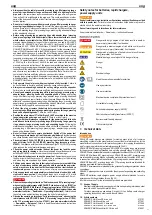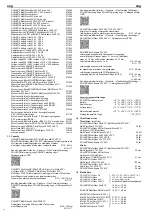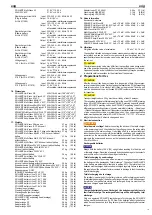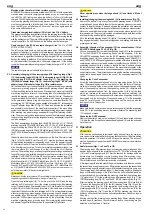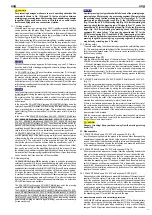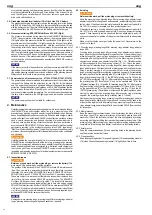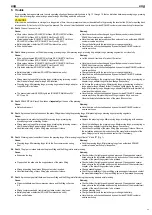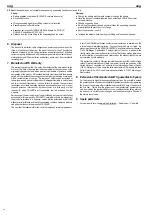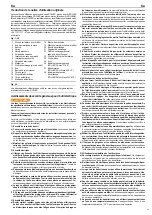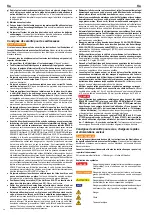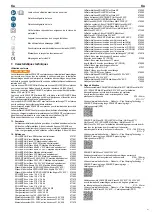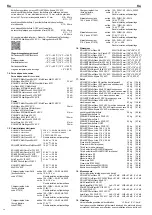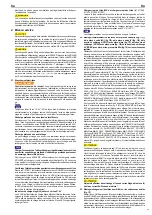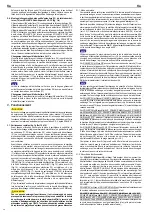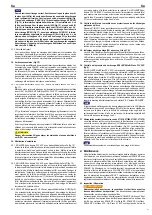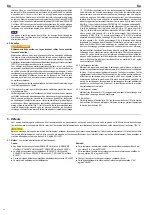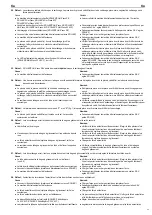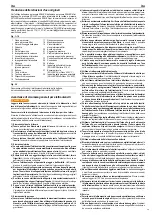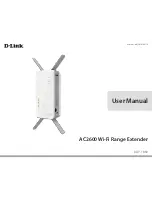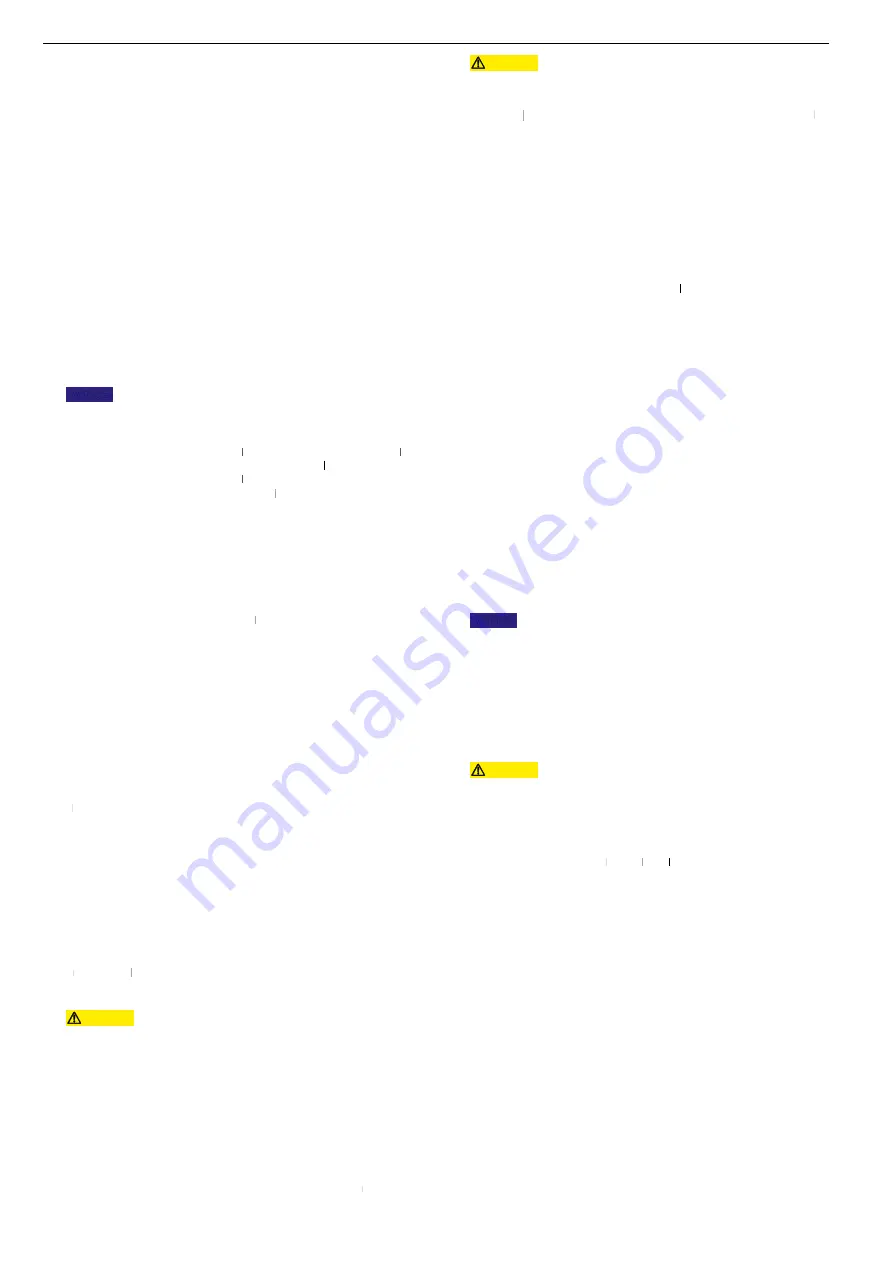
eng eng
Machine status check for all Li-Ion cordless presses
All ROLLER’S cordless presses are available as of 2011-01-01 with an electronic
machine status check with charging state display (23) by a 2-coloured green/
red LED. The LED lights green when the battery is fully or still suffi ciently
charged. The LED lights red when the battery must be charged. If this condition
occurs during pressing and the pressing process is not fi nished, the pressing
must be completed with a fully charged Li-Ion battery. If the drive unit is not
used, the LED goes out after approx. 2 hours but comes on again when the
drive unit is switched back on.
Graduated charging level indicator (26) of the Li-Ion 21.6 V battery
The graduated charging level indicator shows the charging level of the battery
with 4 LEDs. At least one LED lights for a few seconds after pressing the key
with the battery symbol. The more LEDs that light green, the higher the charging
level of the battery. If a LED fl ashes red, the battery must be recharged.
Rapid charger Li-Ion/Ni-Cd and rapid charger Li-Ion (Art. No. 571560,
571575, 571585, 571587)
The left control lamp lights up and remains green when the mains plug is
plugged in. If a battery is inserted in the rapid charger, the green control lamp
fl ashes to indicate that the battery is charging. The green light stops fl ashing
and remains on to signal that the battery is fully charged. If the red control lamp
fl ashes, the battery is defective. If the red control lamp comes on and remains
on, this indicates that the temperature of the rapid charger and / or the battery
is outside the permissible operating range of the rapid charger of 0°C to +40°C.
NOTICE
The rapid chargers are not suitable for outdoor use.
2.2. Assembly (changing) of the pressing tongs, Mini pressing tongs (Fig. 1
(1)), the pressing tongs (4G) (Fig. 15), the pressing tongs (S) (Fig.
15
15
16), the
16
16
pressing ring (PR-3S) with adapter tongs (Fig. 17), the pressing ring
17
17
(PR-3B) with adapter tongs (Fig. 18), the pressing ring 45° (PR-2B) with
18
18
adapter tongs, Mini adapter tongs (Fig. 19) in radial presses.
19
19
Pull out the mains plug or remove the battery. Only use pressing tongs, pressing
tongs Mini or pressing rings with system-specifi c pressing contour according
to the pressfi tting system to be pressed. Pressing tongs, pressing tongs Mini
or pressing rings have letters on the pressing jaws or pressing segments to
identify the pressing contour and a number to identify the size. The adapter
tongs are marked by the letter Z and a number which serves for assignment
to the permissible pressing ring which carries the same identifi cation. The
pressing ring 45° (PR-2B) may only be applied at at angle of 45° to the adapter
tongs Z1/adapter tongs Mini Z1 (Fig. 19). Read and observe the installation
19
19
and assembly instructions of the manufacturer/supplier of the press fi tting
system to be pressed. Never use non-matching pressing tongs, pressing tongs
Mini, pressing ring, adapter tongs and adapter tongs Mini (pressing contour,
size). The press joint could be rendered useless and the machine and pressing
tongs, pressing tongs Mini, pressing ring, adapter tongs and adapter tongs Mini
tongs, pressing tongs Mini, pressing ri
tongs, pressing tongs Mini, pressing ri
could be damaged.
The Z6 XL adapter tongs for driving the ROLLER’S XL 64 – 108, 2½ – 4" (PR-3S)
pressing rings with ROLLER’S Uni-Press XL ACC. The Z7 XL 45 kN adapter
tongs for driving the ROLLER’S XL 64 – 108, 2½ – 4" (PR-3S) and XL 2½ – 4"
(PR-3B) pressing rings with ROLLER’S Multi-Press XL 45 kN 22 V ACC. Only
the Z7 XL 45 kN adapter tongs will fi t the ROLLER’S Multi-Press XL 45 kN 22 V
ACC.
It is be
It
It
st to place the drive machine on a bench or on the fl oor. The rotary sleeve
(Fig. 4 (27)) of ROLLER’S Uni-Press XL ACC must be positioned according
to the pressing tongs/adapter tongs being used. To use the adapter tongs Z6
XL, the rotary sleeve (27) must be turned until it snaps in so that the slit of the
drive housing is not covered. For all other pressing tongs/adapter tongs, turn
the rotary sleeve (27) until it snaps in so that it covers the slit of the drive
housing. The pressing tongs, pressing tongs Mini, adapter tongs and adapter
tongs Mini can only be installed (changed) when the press rollers (5) are fully
retracted. On ROLLER’S Uni-Press SE push the rotation direction lever (7) to
the left and actuate the safety inching switch (8) if necessary, on ROLLER’S
Multi-Press Mini ACC, ROLLER’S Multi-Press Mini 22 V ACC, ROLLER’S
Multi-Press Mini S 22 V ACC / ROLLER’S Uni-Press / Uni-Press ACC / Uni-
Pres
PP s XL ACC and ROLLER’S Multi-Press / Multi-Press ACC / Multi-Press 22 V
s XL ACC
s XL ACC
ACC / ROLLER’S Multi-Press XL 45 kN 22 V ACC, press the reset button (13)
until the press rollers (5) have moved right back.
CAUTION
CAUTION
Always position the rotary sleeve (27) according to the pressing tongs/adapter
tongs being used until these snap in, danger of crushing!
Open the tong retaining bolt (2). To do this, press the bolt (4) and the tong
retaining bolt (2) springs out. Insert the chosen pressing tongs, Mini pressing
tongs (1), adapter tongs, Mini adapter tongs (19). Push forward the tong retai-
ning bolt (2) until the bolt (4) snaps into place. At the same time, press down
the button (3) directly over the tong retaining bolt (2). Do not start radial presses
without pressing tongs, pressing tongs Mini or pressing ring with adapter tongs
and adapter tongs Mini inserted. Only start the pressing process to make a
press joint. Without pressing counterpressure by the press fi tting the drive
machine or pressing tongs, pressing tongs Mini, pressing ring, adapter tongs
and adapter tongs Mini will be exposed to unnecessarily high stress.
and adapter tongs Mini will be exposed to unnecessarily high st
and adapter tongs Mini will be exposed to unnecessarily high st
CAUTION
CAUTION
Never operate press when the tongs shank (2) is not locked. Risk of
fracture!
2.3. Installing (changing) the pressing heads (14) in axial presses (Fig.
2.3. Installing (
2.3. Installing (
11)
11
11
Remove the battery. Only use system-specifi c pressing heads. ROLLER’S
press ing heads have a letter to identify the compression sleeve system and a
number to identify the size. Read and observe the installation and assembly
instructions of the manufacturer/supplier of the used compression sleeve system.
Never use non-matching pressing heads (compression sleeve system, size)
for pressing work. The press joint could be unserviceable, and both the machine
and the press ing heads might be damaged.
Push the selected pressing heads (14) right in, if necessary turning them until
they engage (ball catch). Keep the pressing heads and locating hole inside the
pressing device clean.
2.4. Assembly (changing) of the expander (15), the expanding head (16) on
ROLLER’S Akku-Exparo 22 V ACC (Fig. 10)
10
10
Choose an expander (15) to match the expanding head (16). Use the expander
Cu for the ROLLER’S Cu expanding heads. Use the expander P for the
ROLLER’S P expanding heads. Use the P-CEF expander for the ROLLER’S
expanding heads. Only use system-specifi c expanding heads. ROLLER’S P
and ROLLER’S P-CEF expanding heads are labelled with letters to identify the
compression sleeve system and a number to identify the size, ROLLER’S Cu
expanding heads only with a number to identify the size. Read and observe
the installation and assembly instructions of the manufacturer/supplier of the
used system. Never expand with an unsuitable expander, unsuitable expanding
heads (system, size). The joint could be useless and the machine and expanding
heads could be damaged. Grease the cone of the expanding mandrel (18)
lightly.
Changing the P and Cu expander
Screw the selected expanding head onto the expanding device (18) to the
stop. The expanding device must now be set so that the thrust of the drive
machine is taken up by the drive machine and not the expanding head at the
end of the expanding. Unscrew the expanding device (15) complete with
screwed on expanding head from the drive machine for this. Let the feed
piston run forward as far as possible without the machine switching into
reverse. In this position the expander with screwed-on expanding head must
be screwed onto the drive unit until the expanding jaws (17) of the expanding
head (16) are fully open. The expanding head must be secured with the
locking nut (24) in this position.
NOTICE
Make sure that the compression sleeve is far enough away from the expanding
head (16) in the expanding process because otherwise the expanding jaws
(17) can bend or break.
Changing the P-CEF expander
Remove the battery. Screw on the locking nut (24) and the selected expander
(15) up to the stop. Screw the selected expanding head (16) onto the expander
up to the stop.
3. Operation
CAUTION
CAUTION
After the drive unit has been in storage for a long period of time, the overpres-
sure valve must be actuated fi rst by pressing the reset button (13) before putting
back into operation. If it is stuck or stiff, it may not be pressed. The drive unit
must be handed over to an authorized ROLLER’S customer service workshop
for inspection.
3.1. Radial presses (Figs. 1 to 9 and
99
15 to
15
15 19)
19
19
The pressing tongs, Mini pressing tongs, pressing ring, adapter tongs and Mini
The pressing tongs, M
The pressing tongs, M
adapter tongs, especially the pressing contour (11, 22) of the pressing jaws
(10) or all 3 pressing segments (21) must be checked for damage and wear
before every use. Damaged or worn pressing tongs, Mini pressing tongs,
pressing rings, adapter tongs and Mini adapter tongs may no longer be used.
There is otherwise a risk of incorrect pressing or accidents.
A trial pressing with inserted press fi tting must be made with the drive unit and
the respectively used pressing tongs, Mini pressing tongs and the respectively
used pressing ring with adapter tongs or Mini adapter tongs before every use.
The pressing tongs, Mini pressing tongs (1), the pressing ring (20) with adapter
tongs or Mini adapter tongs must fi t into the drive unit mechanically and be
properly lockable. After completing the pressing, check that the pressing jaws
(10) close fully at “A” for the pressing tongs, Mini pressing tongs (Fig. 1), the
(PR-3B) pressing ring (Fig. 18) and the 45° (PR-2B) pressing ring (Fig. 19).
After completing the pressing, check that the pressing jaws (10) close fully at
“A” and on the opposite side “B” for the (4G) pressing tongs (Fig. 15) and the
(S) pressing tongs (Fig. 16). After completing the pressing, check that the
pressing segments (21) close fully at “A” and on the opposite side “B” for the
(PR-3S) pressing ring (Fig. 17) and the XL (PR-3S) pressing ring. Check the
tightness of the connection (observe national specifi cations, standards, regula-
tions, etc.)
If during closing of the pressing tongs, pressing tongs Mini or pressing rings a
marked ridge is created on the compression sleeve, the pressing may be
defective or not tight (see 5. Trouble).
20
Summary of Contents for Akku-Exparo 22 V ACC
Page 5: ...Fig 18 PR 3B B A 19 20 22 12 12 Fig 19 45 PR 2B PR 2B B 22 A 12 12 20 20 12 19 10 10 5 5 5...
Page 90: ...90...
Page 91: ......

